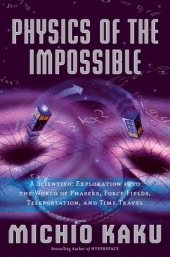 Have you ever been wondering about how the universe got its spots? (Also a nice book by the way) Or do you wonder whether time-travel is possible? Or when teleportation is going to bring you from behind your computer to the other side of the planet within a second? If you think all these science-fiction-like questions are far fetched, you might give the book called Physics of the impossible by Michio Kaku a chance to answer these questions. The book is not too difficult to read and in my case I even read very fast through it. Normally it takes me a few weeks to read a book, but this one took me only two weekends. Which might give you a clue that it is a very interesting book to read.
Have you ever been wondering about how the universe got its spots? (Also a nice book by the way) Or do you wonder whether time-travel is possible? Or when teleportation is going to bring you from behind your computer to the other side of the planet within a second? If you think all these science-fiction-like questions are far fetched, you might give the book called Physics of the impossible by Michio Kaku a chance to answer these questions. The book is not too difficult to read and in my case I even read very fast through it. Normally it takes me a few weeks to read a book, but this one took me only two weekends. Which might give you a clue that it is a very interesting book to read.
The author divides all science-fiction possibilities into three classes. The first class (I) is about technology which is possible within the laws of physics, like teleportation, force fields and antiuniverses and which might become reality within the 21st century, be it at a very small scale. The second class (II) describes subjects like faster-than-light and the discovery of parallel universes. This class is also still possible in theory and the current known physics laws. But it might take a few centuries before civilization can harness these technologies. The last class (III) tells about science-fiction technologies which are completely beyond the capabilities of humans and do violate all current known physics laws. In this class you will find perpetual motion machines and precognition. There is also a discussion about string-theory, which is called the “theory of everything” which states that all matter around us is – simply said – made out of tiny vibrating strings and which give all chemicals and elements their specific properties (besides being just atoms/electrons/protons etc.).
When you read this book you even more realize that everything you see around you is a really impressive representation of our world. Perhaps even more fascinating is the way everything works at a miniature scale and that our world has really strange properties. The author also refers to quotes from scientists in the 20th century who believed that atoms and quantum-mechanics didn’t exist. Today we know better and easily take photo’s of atoms and can even arrange atoms to create nano-sized figures with it. You definitely have to read this book if you want to know what science-fiction might become possible within our lifetime.